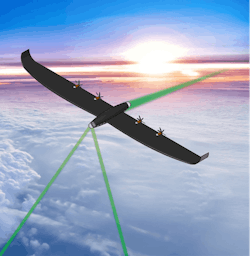Military researchers eye power-beaming technologies for laser-delivered on-demand power for the battlefield
ARLINGTON, Va. – U.S. military researchers are asking for industry's help in demonstrating electro-optical laser power beaming technology as part of a project to design a high-altitude optical relay to create scalable on-demand power networks able to distribute about 10 kilowatts of electricity to military users as far away as 125 miles.
Officials of the U.S. Defense Advanced Research Projects Agency (DARPA) in Arlington, Va., issued a program solicitation (DARPA-PS-24-25) on Wednesday for the POWER Receiver Array Demonstration (PRAD).
PRAD seeks to demonstrate enabling technologies in power beaming, as part of the DARPA Persistent Optical Wireless Energy Relay (POWER) project. POWER seeks to demonstrate optical power-beaming relays not only as a resilient multipath alternative for expeditionary energy transport, but also to enable small-yet-persistent manned and unmanned aircraft to provide on-demand power for a wide range of military missions.
POWER optical technologies are expected to create an airborne relay capable of redirection, wavefront correction, and energy harvesting of optical beams. The ultimate goal is to use three airborne relay nodes hosted on existing aircraft to transmit energy from a ground source laser to 60,000 feet in altitude, and back down to a ground receiver 125 miles away.
The PRAD program seeks to develop and demonstrate a laser power beaming receiver for a future energy web that consists of three major component types: transmitters, relays, and receivers.
Optical laser power beaming delivers energy over long distances via transmission by laser beam that is then directed towards a receiving station. The receiving station is equipped with photovoltaic cells or similar devices that capture the laser energy and convert it back into electrical power.
A ground-to-ground demonstration is crucial for proving the feasibility and effectiveness of optical laser power beaming technology -- particularly in validating the photovoltaic receiver array and its efficiency, DARPA researchers explain.
The RTX Raytheon segment won a $10 million contract in August 2023 for the DARPA POWER project. The next step is to develop and demonstrate a laser power beaming receiver for the POWER program.
POWER seeks balance energy generation, storage, and distribution for military missions by capitalizing on power beaming for near- instantaneous energy transport.
Military power today relies primarily on liquid fuels like jet fuel, gasoline, and diesel fuel, which are vulnerable to enemy attack and require significant infrastructure. Instead, POWER seeks to reduce the military's dependence on liquid fossil fuels, their delivery, and storage capacity.
Speed-of-light energy transport through a multipath network would enable rapid reconstitution under attack, graceful degradation, and resilience by re-routing energy through the network in a matter of seconds or minutes, and restoring full capability by replacing nodes in minutes or hours.
For the POWER program, Raytheon seeks to deliver 10 kilowatts of laser energy to the final ground node using a 50-kilowatt source laser, transmitted through three airborne relay nodes using system apertures smaller than one meter diameter.
Related: High-energy laser weapons ready for the front lines
In POWER's first phase, Raytheon is developing a relay payload design and relay platform. The PRAD part of the POWER program seeks to build a low-power demonstration relay.
Eventually DARPA would like to demonstrate three airborne nodes relaying power to a ground receiver at White Sands Missile Range, N.M., using the High Energy Laser Systems Test Facility (HELSTF), and the RQ-4 Global Hawk large unmanned aircraft as an airborne relay.
Companies interested in demonstrating a POWER laser power beaming receiver as part of the PRAD program should email 3-page abstracts no later than 30 Sept. 2024 to [email protected].
Companies submitting promising abstracts may be invited to give oral presentations. Email questions or concerns to DARPA at [email protected]. More information is online at https://sam.gov/opp/51e880f298304099a8b2f62352617a2f/view.
About the Author
John Keller
Editor-in-Chief
John Keller is the Editor-in-Chief, Military & Aerospace Electronics Magazine--provides extensive coverage and analysis of enabling electronics and optoelectronic technologies in military, space and commercial aviation applications. John has been a member of the Military & Aerospace Electronics staff since 1989 and chief editor since 1995.
